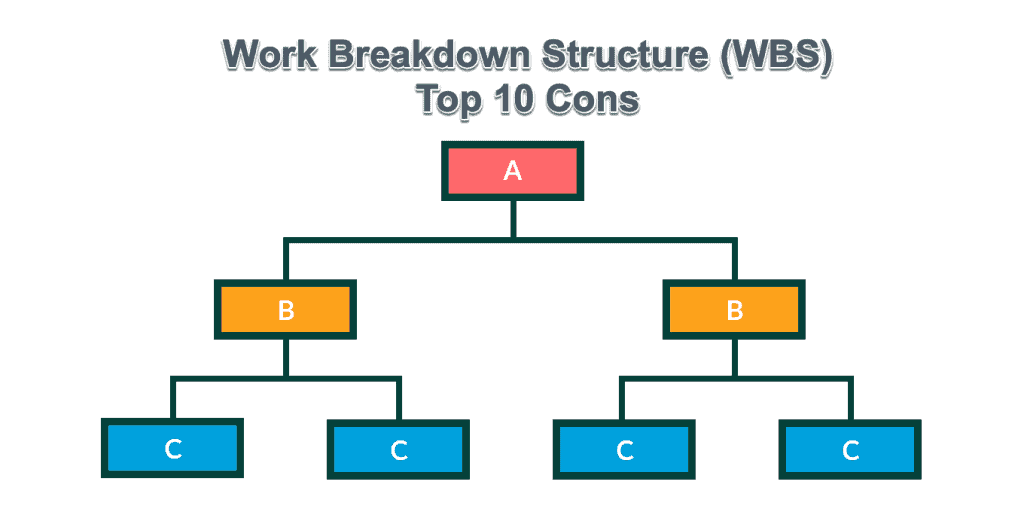Top 10 Cons & Disadvantages: Work Breakdown Structure (WBS)

Work Breakdown Structure (WBS) is a widely acknowledged and applied tool in project management, serving as a foundation for defining work packages and their requisite activities. Its tree-like structure, which breaks projects into smaller, more manageable chunks, ensures clarity and direction. However, while the advantages of WBS are frequently lauded, it is equally important to shed light on its limitations.
Understanding these potential drawbacks is crucial for project managers, stakeholders, and team members, allowing them to make informed decisions and, when possible, mitigate the associated risks.
If you want a tool to manage your projects, consider looking at AceProject. By charging per project instead of per user, this software offers the potential for significant cost savings.
Top 10 Cons or Disadvantages of Using Work Breakdown Structure (WBS)
While WBS can be a formidable asset, it’s essential to approach its use with a discerning eye. The following section will delve into the ten most prominent disadvantages of relying on a Work Breakdown Structure in project management.
1. Rigidity in Planning
One of the most significant disadvantages of using a Work Breakdown Structure is its inherent rigidity. Designed to provide a detailed and comprehensive project plan, the WBS often locks teams into a fixed path. This rigidity can be detrimental in projects where flexibility and adaptability are key. While beneficial for clarity, the detailed decomposition of tasks can become a hindrance when unforeseen changes or innovations are required. This lack of flexibility can lead to delays and increased costs as teams struggle to adapt the WBS to accommodate new developments or changes in project scope.
Furthermore, the rigid structure of a WBS may stifle creativity and innovation within the team. When every task is pre-defined and structured, there is little room for team members to explore alternative approaches or solutions that may be more effective. This can lead to a ‘tunnel vision’ effect, where the focus is on ticking off tasks rather than finding the best way to achieve the project’s objectives. Additionally, the effort involved in updating the WBS for every minor change can be time-consuming and labor-intensive, further contributing to inefficiencies.
2. Complexity and Over-detailing
WBS can quickly become overwhelmingly complex, especially in large-scale projects. The drive to break down every task into its smallest component can lead to excessive detailing, making the WBS convoluted and difficult to manage. This over-detailing can confuse team members, obscure the bigger project picture, and make it challenging to identify critical paths and priorities. Moreover, the time and resources spent creating an overly detailed WBS may not justify the benefits, leading to inefficiency and wasted effort.
The complexity of a highly detailed WBS also poses challenges in communication. Stakeholders who are not intimately involved in the day-to-day management of the project may find it hard to understand or engage with an overly complex WBS. This can lead to miscommunication and misalignment of expectations, particularly when conveying project progress or changes. Additionally, the effort required to maintain and update a highly detailed WBS can be substantial, diverting valuable resources away from actual project work.
3. Time-Consuming to Create and Update
Developing a comprehensive WBS is a time-consuming process that requires a thorough understanding and analysis of the project. It involves breaking down the project into smaller parts and can take significant time, delaying the project’s actual start. This initial time investment might be justified for large and complex projects, but for smaller or more straightforward projects, the time spent on creating a WBS could be seen as unnecessary overhead.
Updating the WBS is equally time-consuming. Projects are dynamic, and as changes occur, the WBS needs to be revised to reflect these changes. This continuous updating process can become a project, consuming resources that could be better used in actual project execution. In fast-paced environments, where changes are frequent and swift, the time lag in updating the WBS can lead to discrepancies between the plan and the actual project status, leading to confusion and mismanagement.
4. Reliance on Initial Assumptions
A Work Breakdown Structure is heavily reliant on the initial assumptions and understanding of the project at its outset. The entire structure can become flawed if these assumptions are incorrect or incomplete. This reliance on initial assumptions is risky because it assumes a level of understanding and predictability often absent in complex projects. Projects, especially large ones, are subject to various internal and external factors that can change rapidly and unpredictably, rendering initial assumptions obsolete.
Moreover, this reliance can lead to a false sense of security, as project managers may become overly confident in the comprehensiveness of the WBS. This overconfidence can result in inadequate contingency planning and a lack of preparedness for unexpected developments. In scenarios where the project deviates significantly from its initial path, the WBS can become more of a hindrance than a help, as it may not accurately reflect the current state and needs of the project.
5. Difficulties in Accommodating Scope Changes
The rigid nature of a WBS makes accommodating changes in project scope particularly challenging. When changes occur, they often affect multiple levels of the WBS, requiring a comprehensive review and update of the structure. This can be a complex and time-consuming process, especially for large and intricate projects. In some cases, significant scope changes might necessitate a complete overhaul of the WBS, which can be daunting and resource-intensive.
Moreover, integrating scope changes into an existing WBS can lead to inconsistencies and errors. As the structure becomes more complex with each change, the likelihood of overlooking critical interdependencies or duplicating tasks increases. This can lead to inefficiencies and a lack of cohesion in the project management process. Additionally, frequent scope changes can cause frustration and confusion among team members, as they struggle to keep up with the evolving project plan.
6. Potential for Misalignment with Agile Methodologies
The structured and hierarchical nature of WBS often clashes with the principles of agile methodologies,
which emphasize flexibility, adaptability, and incremental progress. Agile approaches, such as Scrum or Kanban, thrive on the ability to rapidly adjust to changing requirements and stakeholder feedback. In contrast, with its fixed and detailed structure, a WBS can be seen as antithetical to this agile mindset. This misalignment can create significant challenges in projects that aim to integrate traditional project management practices with agile methodologies.
The rigidity of a WBS can hinder the iterative and incremental progress central to agile approaches. Agile projects often require the freedom to reprioritize tasks and alter scopes on the fly, which a predefined WBS may obstruct. This can lead to conflicts in project teams, as members adhering to the WBS might resist changes proposed by those favoring agile practices. Furthermore, the time and effort required to revise a WBS in response to agile cycles can be counterproductive, negating the efficiency and responsiveness that agile methodologies seek to achieve.
7. Resource Allocation Challenges
WBS can sometimes oversimplify the complexities involved in resource allocation. By breaking down the project into tasks, it may create an illusion of linear and independent task sequences, ignoring the often complex interdependencies between tasks and the resources they require. This can lead to inaccurate estimation of resource needs, either underestimating or overestimating the required input, which in turn impacts project costs and timelines.
Moreover, the static nature of a WBS does not account for the dynamic nature of resource availability. Team members may be involved in multiple projects or aspects of a project, and their availability can change unexpectedly. The WBS, however, typically does not reflect these fluctuations in resource availability, leading to scheduling conflicts and inefficiencies. Additionally, the focus on tasks rather than outcomes can result in a misalignment of resources with the most critical project objectives, potentially impacting the overall success of the project.
8. Overemphasis on Task Completion
The structure of a WBS can inadvertently promote a culture focused more on task completion than on achieving overall project objectives. The hierarchical breakdown of tasks can lead team members to concentrate on checking off items on a list, rather than understanding and contributing to the broader project goals. This overemphasis on individual tasks can undermine the importance of synergy and collaboration in achieving project success.
Furthermore, this task-oriented mindset can lead to a piecemeal approach to project management, where the cohesive vision of the project is lost. Team members might become so engrossed in their specific tasks that they lose sight of how their work integrates with others’ efforts, leading to inconsistencies and gaps in the project. The lack of a big-picture perspective can also stifle innovation, as team members focus on delivering predefined tasks rather than exploring more effective or efficient ways to achieve project objectives.
9. Underestimation of Soft Factors
A WBS typically focuses on tangible tasks and deliverables, often overlooking the ‘soft factors’ such as team dynamics, stakeholder relationships, and communication channels. These intangible elements are crucial to the success of any project but may not be adequately represented or valued in a WBS. The failure to recognize and plan for these soft factors can lead to challenges in team cohesion, stakeholder engagement, and effective communication.
Ignoring these aspects can also result in a lack of preparedness for dealing with human elements such as resistance to change, interpersonal conflicts, and motivational issues. These factors can significantly impact project progress but may not be evident in a task-oriented WBS. Consequently, a project manager relying solely on a WBS may be ill-equipped to handle the nuanced and often critical human elements of project management.
10. Potential for Siloed Work
Finally, the compartmentalized nature of a WBS can lead to siloed work practices within project teams. By breaking the project into distinct tasks and subtasks, team members may become isolated in their specific areas of work, with limited interaction or understanding of other areas. This can hinder collaboration and knowledge sharing, critical components for the success of complex projects.
Siloed work can also lead to inconsistencies and misalignments between different project parts, as each segment may develop independently without a cohesive strategy. This lack of integration can result in duplication of efforts, gaps in project deliverables, and a disjointed final product. Encouraging cross-functional collaboration and a holistic understanding of the project is essential, yet a WBS might inadvertently work against this objective.
What is a Work Breakdown Structure (WBS)?
A Work Breakdown Structure (WBS) is a project management tool designed to capture project tasks in a visual, organized manner. The WBS breaks the project into smaller components, making it easier to manage and evaluate.
It typically uses a hierarchical tree structure to depict the subdivision of efforts required to achieve an objective, like a product, service, or project. Each descending level represents an increasingly detailed description of the project tasks, ensuring nothing is overlooked.
Conclusion
While the Work Breakdown Structure offers invaluable insights and structure for projects, it has shortcomings. Being aware of these pitfalls allows for more strategic implementation, ensuring the WBS serves as an aid rather than a hindrance. As with any tool, its effectiveness largely hinges on how it’s employed.
It is crucial for project managers to understand its limitations, be prepared to adjust as necessary, and use it in tandem with other methodologies to ensure project success.



